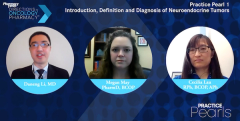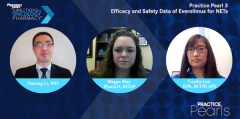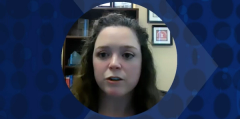
Practice Pearl 3 Unmet Needs in the Treatment of Neuroendocrine Tumors
Megan May, PharmD, BCOP, Cecilia Lau, RPh, BCOP, APh, and Daneng Li, MD, share their thoughts on unmet needs in the management of neuroendocrine tumors.
Daneng Li, MD: Looking toward the future, I would love your opinions in terms of what you feel are the unmet needs and continued challenges in the treatment of neuroendocrine tumors. What do you see in the next 5 years? What is it going to look like for the treatment of neuroendocrine tumors?
Megan May, PharmD, BCOP: We are going to continue to expand treatment options for the neuroendocrine tumors, and we are going to continue to look for ways to have more curative approaches too for our more locally advanced or localized neuroendocrine tumors. One thing I want to encourage the audience and pharmacists to do is make sure you are staying up-to-date with the data. They are changing, and knowing these medications, the mechanism of action, the safety, and the efficacy of each of these is important because they will continue to evolve, as will the more targeted agents that we can now use and will continue to use. I would also encourage everyone to tell their patients about ongoing clinical trials and the importance of enrolling our patients in clinical trials to continue to advance the treatment of these neuroendocrine tumors.
Cecilia Lau, RPh, BCOP, APh: Ideally, of course, there will be more information on how to best sequence our treatment options, especially because there may be more agents coming on the market in the future from a number of ongoing clinical trials. If they show good results, we can expect more treatments in the future.
We want to mention that, for drugs shown to be beneficial in a clinical trial, some patients may want or need access to medications that are not necessarily approved for their neuroendocrine diagnosis but are on the market for other diagnoses. We should also be prepared to help patients obtain either insurance approval or through compassionate-use programs to obtain these medications if patients need them.
Daneng Li, MD: Both of you highlighted the unmet needs and challenges. One is the sequencing in terms of the treatments we have available. The next is that there is a wealth of various clinical trials in terms of newer agents that are being developed for neuroendocrine tumors. How can we quickly get access for those patients? Sometimes a phase 3 study for a clinical trial might take a long time to do, and we already have relatively good phase 2 data. Being able to introduce that access to patients earlier while they are waiting for possible phase 3 data to approve, mature, and ultimately get approved by regulatory agencies is going to be paramount moving forward.
With that, thank you both for doing this with me. It is helpful in terms of providing your expert opinions on helping patients with neuroendocrine tumors with the treatments that we have, as well as some of the challenges with the treatments we are potentially prescribing. We are able to look toward the future in terms of additional options that are going to be helpful for our patients. To our viewing audience, we hope that you found this Directions in Pharmacy® Practice Pearls discussion to be rich and informative, and we look forward to seeing you next time. Thank you so much.
Newsletter
Stay informed on drug updates, treatment guidelines, and pharmacy practice trends—subscribe to Pharmacy Times for weekly clinical insights.






























































































































































































































